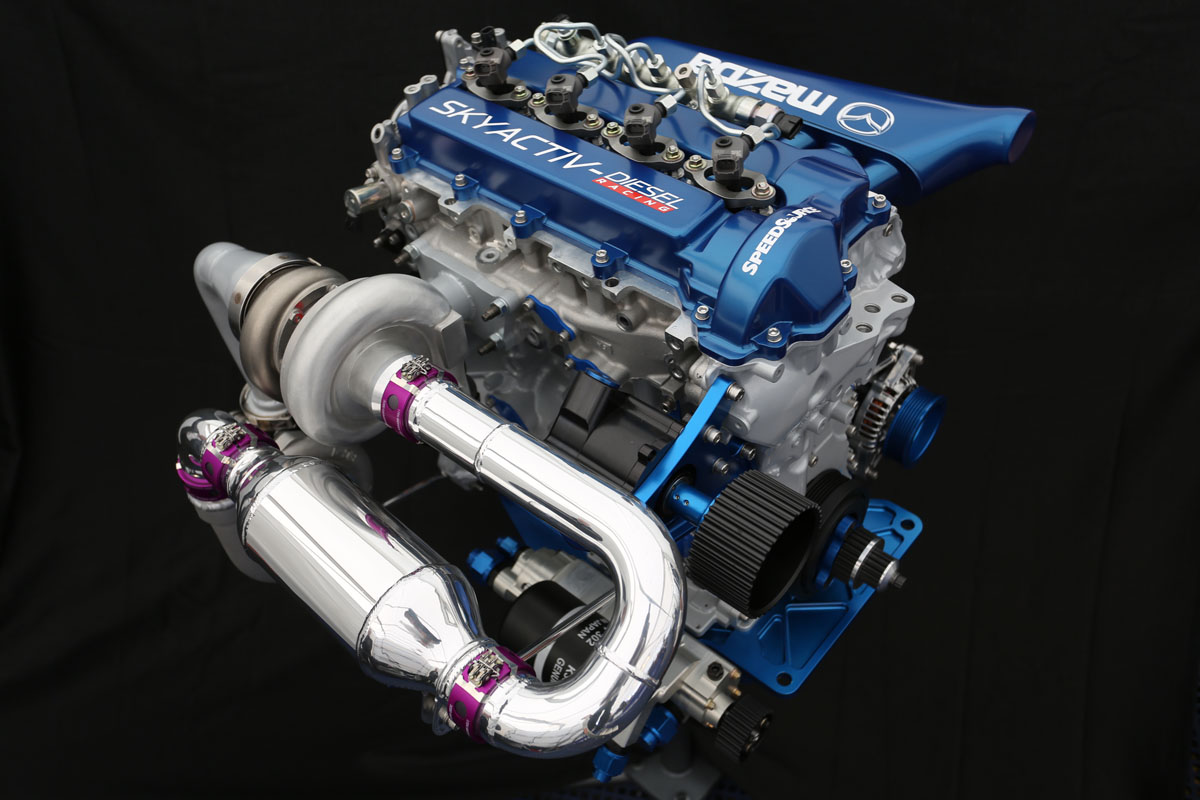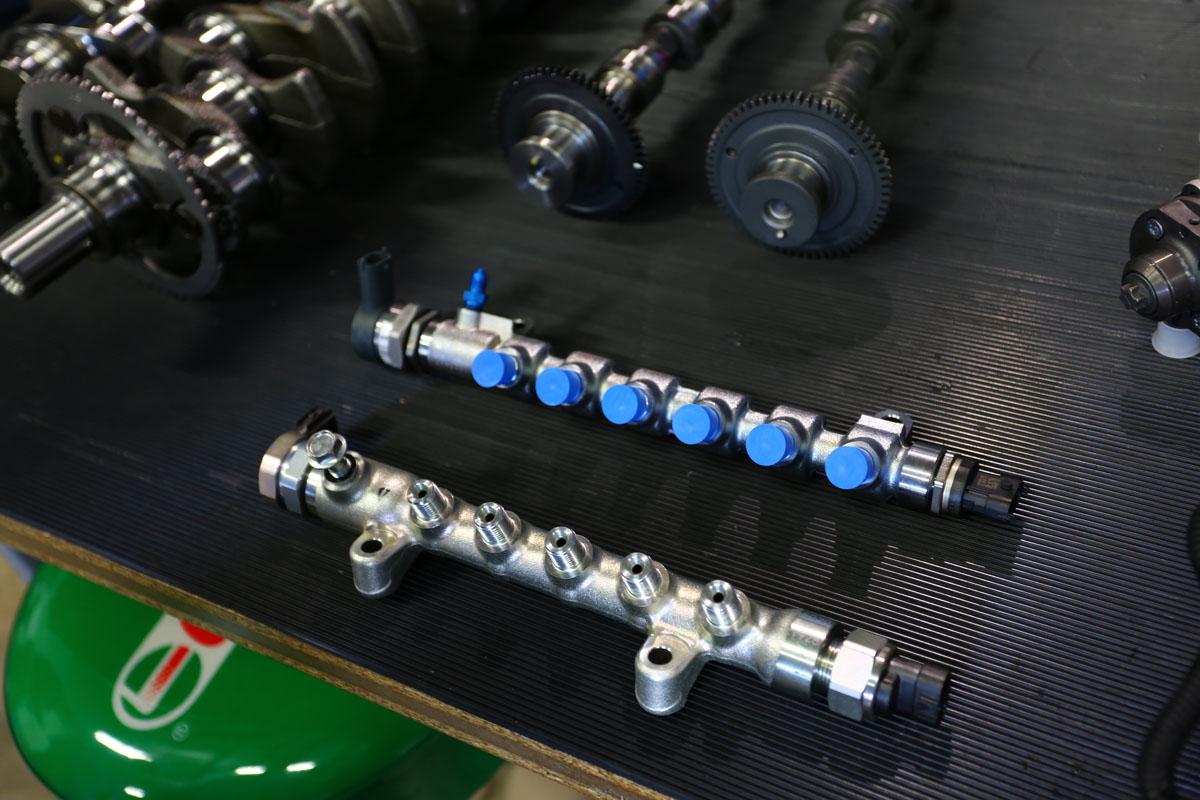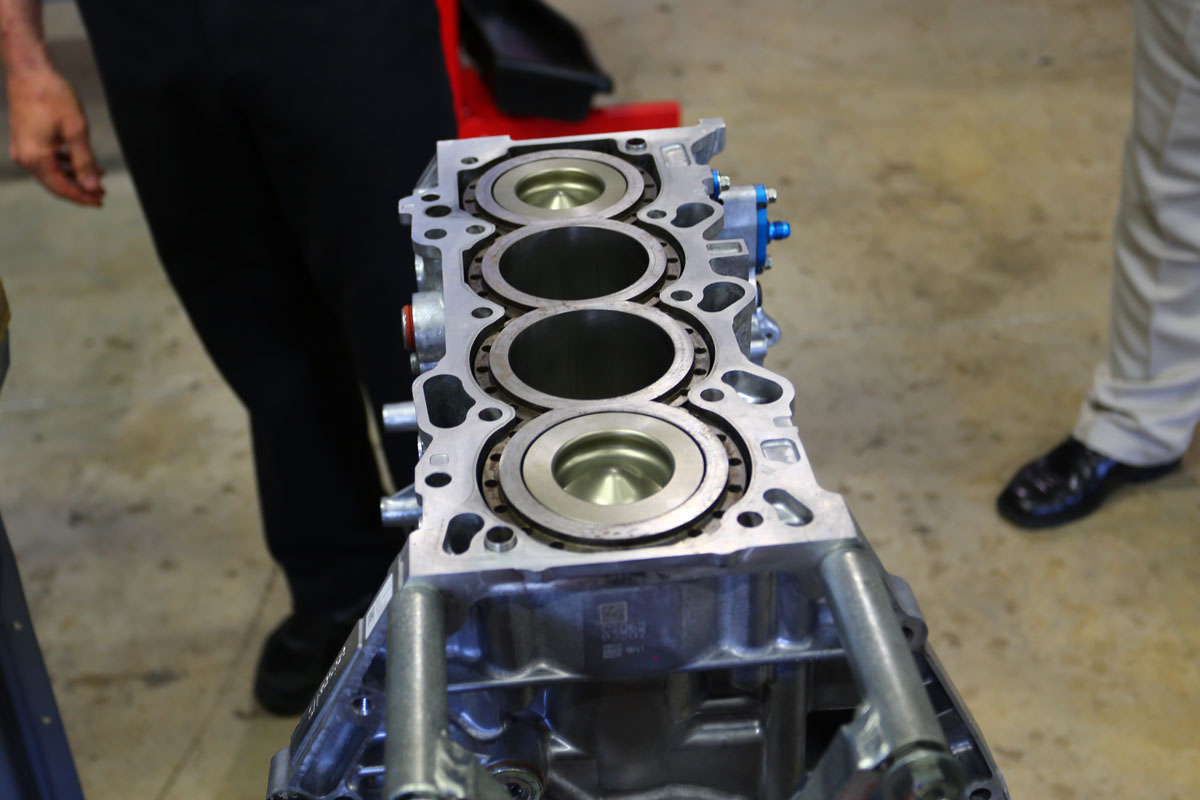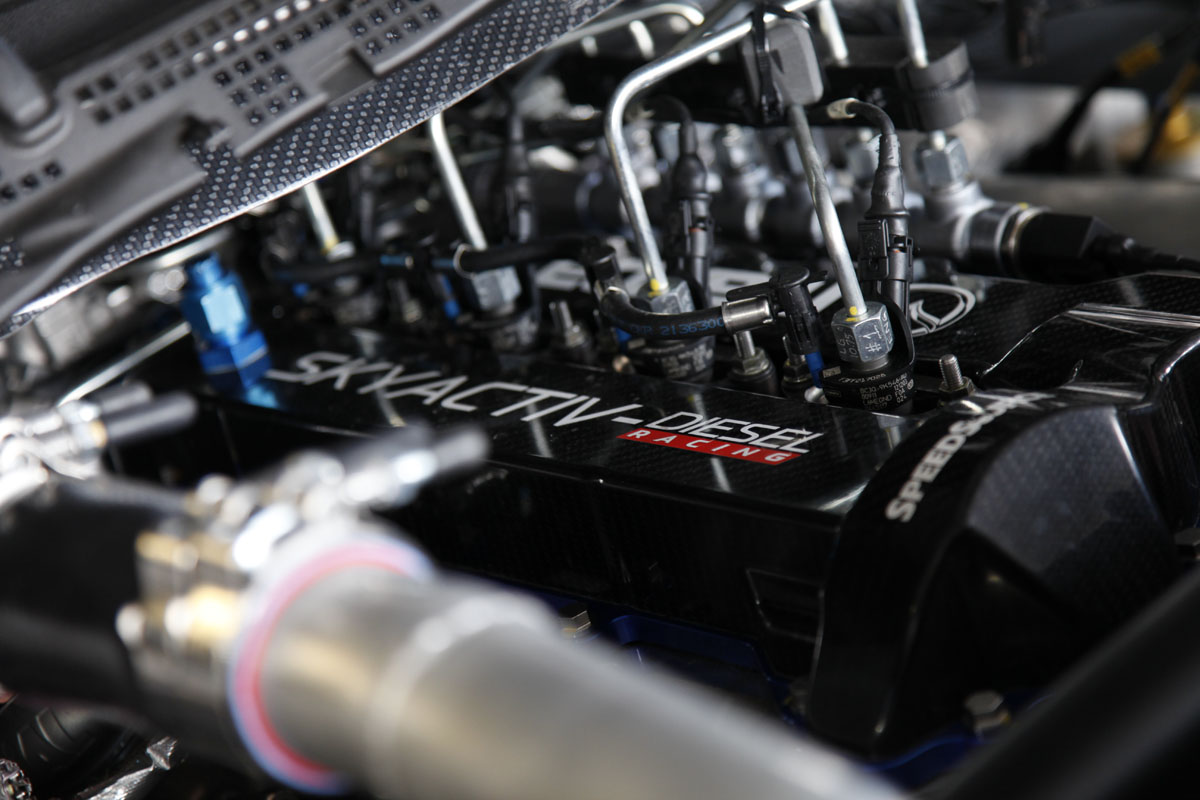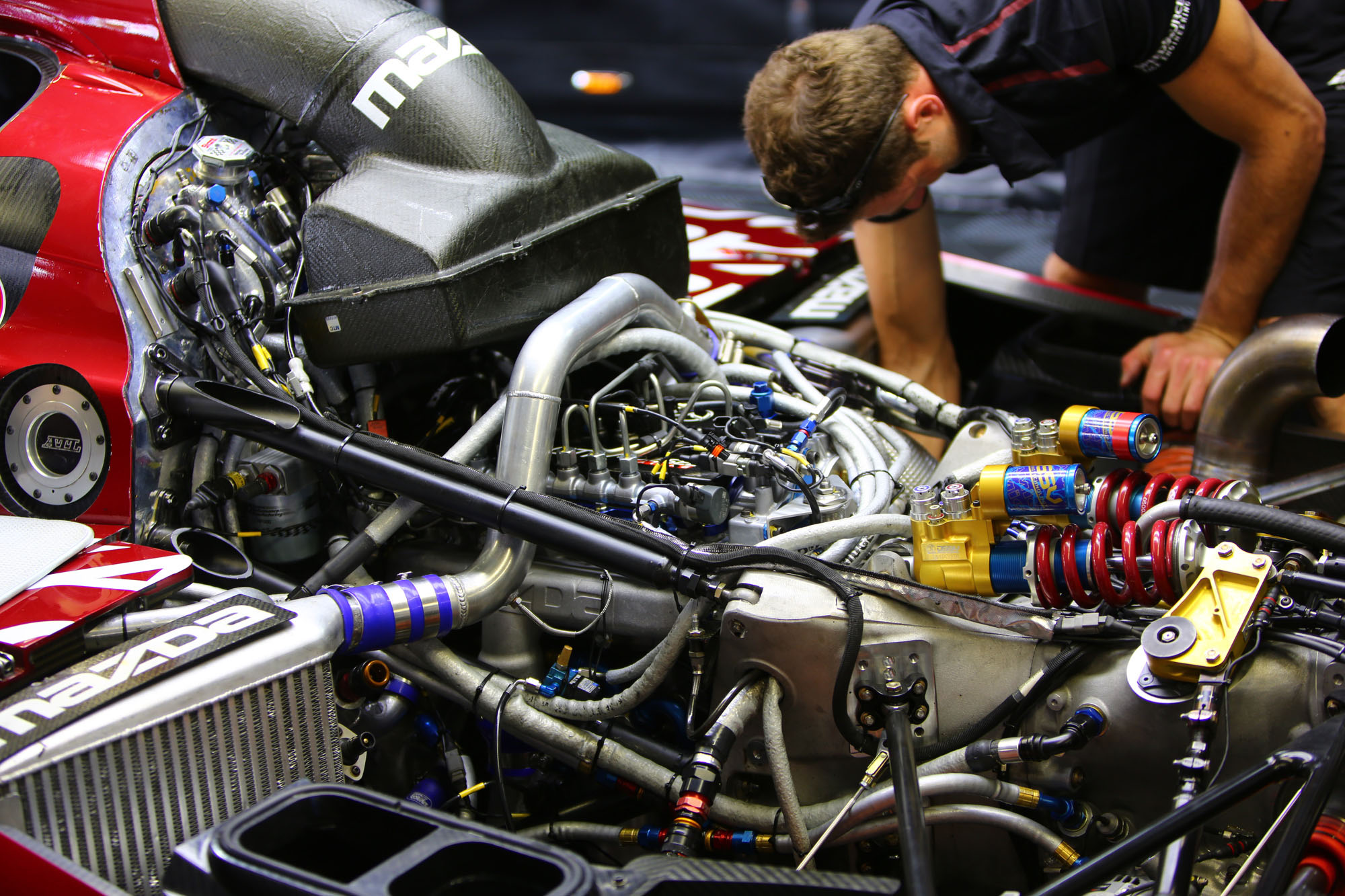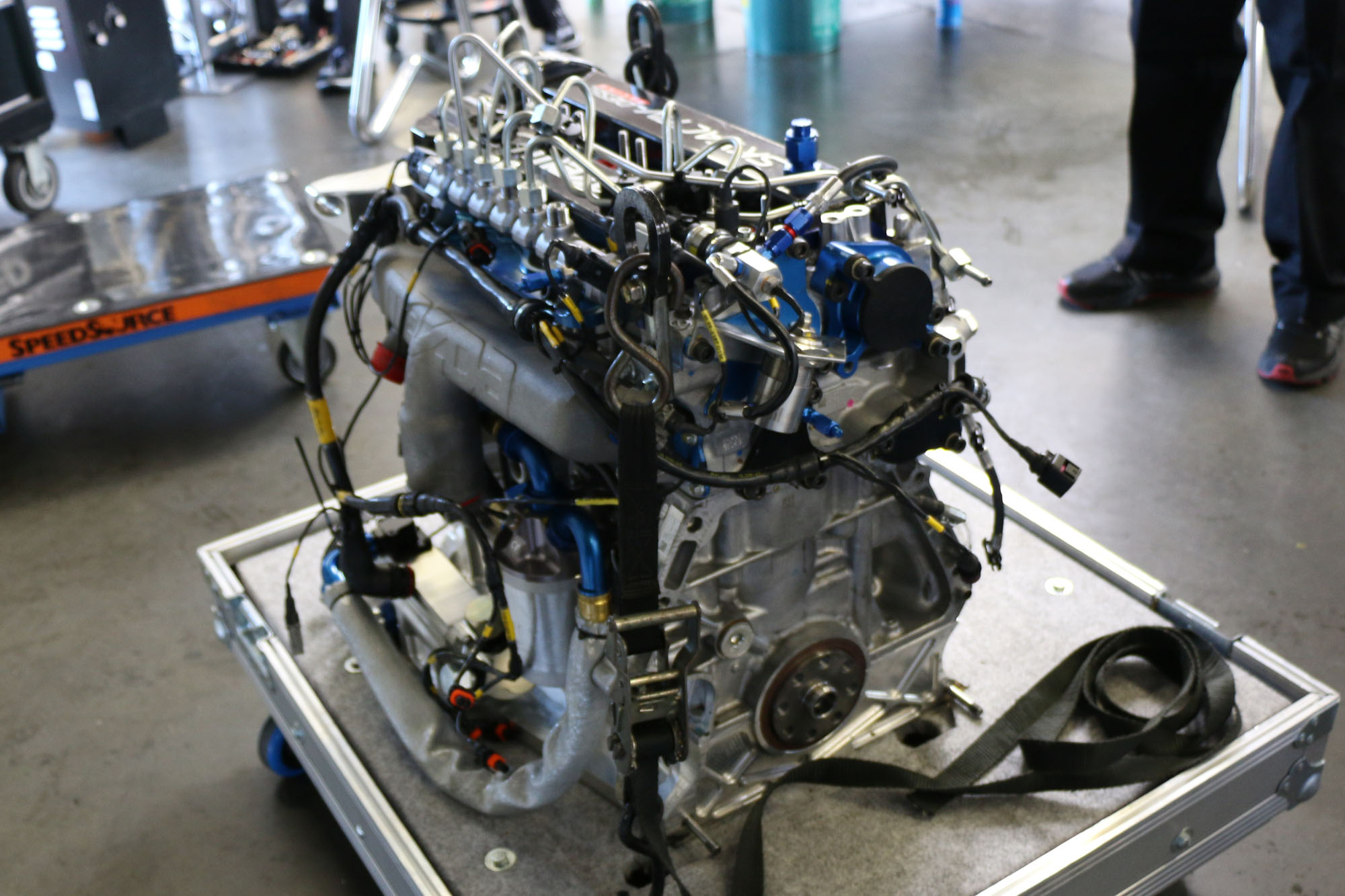- 2014/07/30
Mazda SKYACTIV-D racing engine
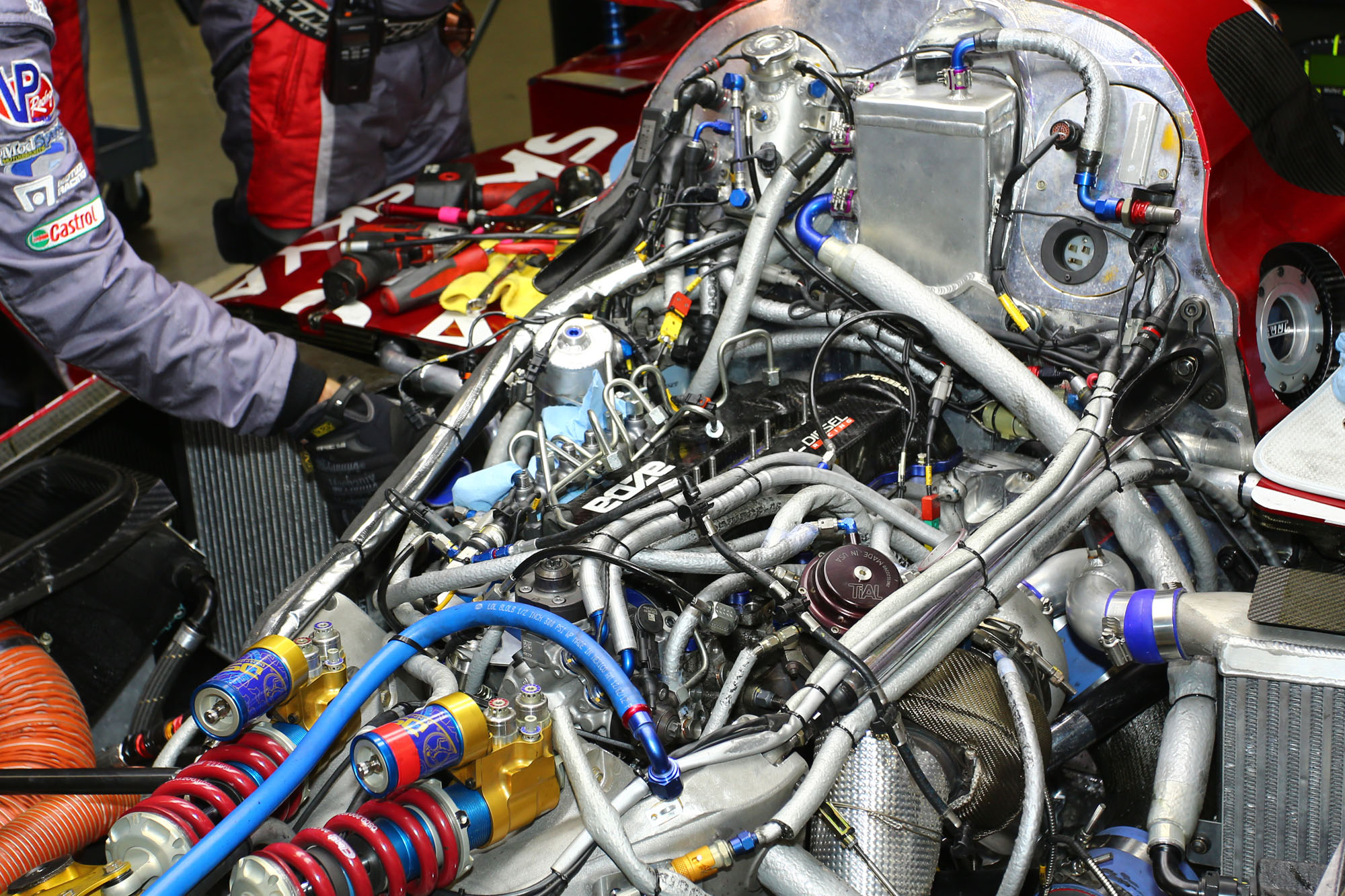
The SKYACTIV-D engine first debuted when it was mounted in the Mazda CX-5. After also being used in the Atenza and Axela it went on to create a whole new category of car in Japan; the “sporty diesel.” Based on this engine, the 2.2-liter DOHC four-cylinder diesel 2-stage turbo SKYACTIV-D racing engine began development in January 2012. In February of the same year production was ceased for the market CX-5 mass production engine and one of these was sent to SpeedSource Engineering so that serious development of the racing version could begin in earnest. This development entailed an engine block that utilized mass produced products. With regards to structural components, the necessary engine durability required to handle the increased power output was improved while avoiding (as much as feasible) the use of replacement materials. Furthermore the valve train system also continues to use the original production parts. Although the conrod and crankshaft are made of replacement materials, the pistons for the first diesel racer, the Mazda 6 GX, are aluminum. The design of the race engine was reinforced and, after they confirmed that it could handle 50 hours of non-stop operation without failure on the engine dyno, numerous test runs were carried out in Daytona mode (consisting of repeated acceleration and deceleration).
However, when the engine first debuted at the 2013 24 Hours of Daytona it ran into successive difficulties and, 3 hours after the start of the race, the 3 Mazda 6 GXs mounted with SKYACTIV-D racing engines were forced to retire. The cause of these problems lay in the amount of vibration within the engine body. These vibrations would often cause the fuel line to bend resulting in fuel leaks. Furthermore, one of the cars experienced internal engine damage brought about by abnormal combustion. As the season had just begun, the teams were faced with the daunting task of simultaneously preparing for races while continuing to develop the engine. To achieve this, experts in engine analysis and materials, as well as diesel engine specialists from both the Mazda headquarters in Hiroshima and the Mazda USA R&D center in California, were dispatched to SpeedSource, the initial base of development, in order to find a solution. This resulted in the shape of the combustion chambers being redesigned to resolve the abnormal detonation issues and, to address the vibration, a number of new concepts being incorporated into the engine and chassis. These efforts paid off and 1 month after Daytona, one of the Mazda 6 GXs carried out a complete run at the Grand-Am second round in Austin. Following this, more improvements continued to be carried, out one after the other, to achieve even more stable performance and the engine went on to achieve 9 consecutive victories in the GX class. Mazda would ultimately shine here as the class manufacturers champion for 2013.
After the 2013 season finished in September, a program was started which aimed at mounting this technology into a prototype car and modifications to the engine body were begun in order to integrate it into the new chassis. To begin with, the lubrication system was reformed and the engine body was altered to enable positioning even lower than in GX chassis. In addition, to increase the cooling capacity essential for the engine’s mid-ship mount, additional pieces were mounted to the water jacket. In spite of this, when competing at the 2014 24 Hours of Daytona, the temperature of the engine could not be effectively regulated and this led to overheating. The SKYACTIV-D engine for prototype chassis has increased the power of the GX engine from 380hp to 450hp. This increase in output has been achieved through the fuel delivery system provided by Bosch. The issues with overheating that have dogged the engine since Daytona are gradually being resolved through adjusting elements such as air-flow control. However, as further increases in output are planned for the future, even greater cylinder head durability will be required. Most likely the only way to confirm this will be through repeated trial and error. With the current 450hp specs the engine as been about 4-5 seconds behind the leading group in qualifying, but when it comes to the final race this difference gets reduced to 2-3 seconds. Being a low-rev, high torque engine, this turbo diesel is much more fuel-efficient compared to V8 machines and it is certain that the Mazda LMP2 SKYACTIV-D Racing will become increasingly competitive in the future.
Owners of Mazda diesel cars such as the CX-5, Atenza and Axela can be proud that they are using the same SKYACTIV-D engine that is going up against the giants of the racing world.
Photo by MZRacing
However, when the engine first debuted at the 2013 24 Hours of Daytona it ran into successive difficulties and, 3 hours after the start of the race, the 3 Mazda 6 GXs mounted with SKYACTIV-D racing engines were forced to retire. The cause of these problems lay in the amount of vibration within the engine body. These vibrations would often cause the fuel line to bend resulting in fuel leaks. Furthermore, one of the cars experienced internal engine damage brought about by abnormal combustion. As the season had just begun, the teams were faced with the daunting task of simultaneously preparing for races while continuing to develop the engine. To achieve this, experts in engine analysis and materials, as well as diesel engine specialists from both the Mazda headquarters in Hiroshima and the Mazda USA R&D center in California, were dispatched to SpeedSource, the initial base of development, in order to find a solution. This resulted in the shape of the combustion chambers being redesigned to resolve the abnormal detonation issues and, to address the vibration, a number of new concepts being incorporated into the engine and chassis. These efforts paid off and 1 month after Daytona, one of the Mazda 6 GXs carried out a complete run at the Grand-Am second round in Austin. Following this, more improvements continued to be carried, out one after the other, to achieve even more stable performance and the engine went on to achieve 9 consecutive victories in the GX class. Mazda would ultimately shine here as the class manufacturers champion for 2013.
After the 2013 season finished in September, a program was started which aimed at mounting this technology into a prototype car and modifications to the engine body were begun in order to integrate it into the new chassis. To begin with, the lubrication system was reformed and the engine body was altered to enable positioning even lower than in GX chassis. In addition, to increase the cooling capacity essential for the engine’s mid-ship mount, additional pieces were mounted to the water jacket. In spite of this, when competing at the 2014 24 Hours of Daytona, the temperature of the engine could not be effectively regulated and this led to overheating. The SKYACTIV-D engine for prototype chassis has increased the power of the GX engine from 380hp to 450hp. This increase in output has been achieved through the fuel delivery system provided by Bosch. The issues with overheating that have dogged the engine since Daytona are gradually being resolved through adjusting elements such as air-flow control. However, as further increases in output are planned for the future, even greater cylinder head durability will be required. Most likely the only way to confirm this will be through repeated trial and error. With the current 450hp specs the engine as been about 4-5 seconds behind the leading group in qualifying, but when it comes to the final race this difference gets reduced to 2-3 seconds. Being a low-rev, high torque engine, this turbo diesel is much more fuel-efficient compared to V8 machines and it is certain that the Mazda LMP2 SKYACTIV-D Racing will become increasingly competitive in the future.
Owners of Mazda diesel cars such as the CX-5, Atenza and Axela can be proud that they are using the same SKYACTIV-D engine that is going up against the giants of the racing world.
Photo by MZRacing
Archive
2024
2023
- 07/10
Mad Mike Breaks Records at Pikes Peak - 05/03
S-Tai Completes Official Testing for 24 Hours of Fuji
2022
2021
- 11/16
Mazda wins 2021 Petit Le Mans in last race for the Mazda RT24-P  10/01
10/01
Tenacity maintains Mazda Motorsports’ third place in the IMSA WeatherTech SportsCar Championship standings 09/22
09/22
Frustrating fifth in Monterey for Multimatic Motorsports 08/16
08/16
Idemitsu No. 55 Mazda Motorsports Mazda DPi Takes Second at Road America 06/30
06/30
Mazda’s DPi Win at Watkins Glen Good to the Last Drop 06/18
06/18
Championship hunt still on for Mazda Motorsports after a bruising race in Detroit 05/21
05/21
Mazda take another podium at Mid-Ohio 03/24
03/24
Mazda RT24-P takes 2nd place in IMSA Sebring 12 Hours 02/01
02/01
Mazda RT24-P Takes Miraculous 3rd at the 24 Hours of Daytona 01/29
01/29
Countdown Begins for 2021 Daytona 24 Hour Race
2020
 11/16
11/16
Mazda RT24-P takes overall victory legendary 12 Hours of Sebring 11/15
11/15
Multimatic enjoys change in fortune with the Mazdas back on upward curve at Laguna Seca 10/23
10/23
Lady Luck dominates Multimatic Motorsports’ Petit Le Mans weekend 10/02
10/02
Mazda RT24-Ps finish 4th and 5th at Mid-Ohio 09/07
09/07
2nd place finish for #55 Mazda RT24-P at Road Atlanta 08/04
08/04
Mazda RT24-Ps grab 5th and 6th at Road America 07/06
07/06
Mazda RT24-P Welcomes Season Return with 1-2 Finish at Daytona 240 01/27
01/27
Mazda Drives To Second Place In Rolex 24 At Daytona 01/26
01/26
Mazda RT24-P earns Daytona pole for second consecutive year 01/09
01/09
Pla and Mazda Qualify First, Set Unofficial Daytona Course Record
2019
 12/10
12/10
Mazda 2 R1 Has Amazing Debut at the FIA NACAM Rally 10/24
10/24
IPS “Jinba Ittai Academy’s” Mushitani grabs first win 10/15
10/15
Mazda Team Joest Just Misses Victory At Petit Le Mans 10/02
10/02
Mazda Unveils Mazda3 TCR 09/20
09/20
After Close S-Tai ST-5 Motegi Race, Demio Takes 2nd and Roadster 3rd 09/20
09/20
Sixth For Mazda In Monterey 09/01
09/01
RE Miata’s 2019 Bonneville effort struggles with loose salt 08/06
08/06
Mazda Scores IMSA Hat Trick 07/08
07/08
Mazda Doubles Down With Second Straight Victory 07/01
07/01
Mazda Dominates In Watkins Glen For Breakthrough IMSA Victory 06/10
06/10
Up and Down Day in Detroit for Mazda 05/09
05/09
Mazdas Battle to Double Podium at Mid-Ohio 04/26
04/26
Okada Demio 15MB Takes 3rd place at JRC round 3 04/16
04/16
Mazda Comes Home Fourth in Long Beach 03/18
03/18
Mazda Team Joest finish 6th and 11th at Sebring 12 hours 01/28
01/28
Two Mazda RT24-Ps retire due to technical trouble 01/28
01/28
Mazda RT24-P grabs pole position
at Daytona 24 official qualifying 01/25
01/25
24 Hours of Daytona Race Week Begins
2018
 10/23
10/23
Double Podium For Mazda At Petit Le Mans 10/09
10/09
Nikko Reger Claims Global Mazda MX-5 Cup Championship 09/14
09/14
Mazda Dominates Before Finishing Fourth At Laguna Seca 08/20
08/20
#720 RE Miata Records 280km/h at Bonneville 08/07
08/07
Mazda Narrowly Misses Victory At Road America 07/24
07/24
Sixth Place in Canada for Mazda Team Joest 07/06
07/06
Mazda Finishes Tenth At Watkins Glen 06/26
06/26
RE Powered MX-5 Miata Set to Once Again Challenge the Bonneville Salt Flats 05/09
05/09
Mazda Scores First Podium of the Season at Mid-Ohio 04/16
04/16
Fighting Fourth At Long Beach For Mazda 03/19
03/19
The Mazda RT24-P Encounters Misfortune With the Podium in Sight 03/17
03/17
Mazda Team Joest Prepared For 12 Hour Challenge Of Sebring 03/16
03/16
Mazda Team Joest Charges To Sebring 01/29
01/29
Mazda Team Joest Have a Rough Start to the IMSA Season 01/27
01/27
The Teams Take It Easy on Friday Ahead of the 24 Hours of Daytona 01/26
01/26
24 Hours of Daytona Schedule Officially Kicks Off
2017
 08/17
08/17
RE Miata Falls Short of Rewriting Bonneville Record 07/12
07/12
Strong Performances See Mazda RT24-Ps Finish in Top 5 07/04
07/04
Mazda Prototype Team Grabs Second Consecutive 3rd Place Podium Finish 06/05
06/05
#70 Mazda RT24-P Grabs 3rd Place at Belle Isle 05/09
05/09
Rough Day at COTA For the Mazda Prototypes 03/20
03/20
Mazda RT24-P Passes Checkered Flag After a Tough 12 Hours of Sebring 02/01
02/01
Mazda RT24-P Falls Short of Checkered Flag at 24 at Daytona 01/28
01/28
On The Cusp of the 55th Rolex 24 At DAYTONA
2016
 10/18
10/18
Mazda Prototype Misses Out on Podium Finish at Petit Le Mans 09/12
09/12
Yui Tsutsumi Takes 3rd Place Podium in Global MX-5 Cup Invitational Race 2 09/12
09/12
Tsutsumi Grabs 8th in Global MX-5 Invitational Race 09/12
09/12
Tsutsumi Secures 5th Place in Global MX-5 Cup Invitational Race Qualifying 09/09
09/09
Mad Mike’s HUMBUL RX-7 Grabs 9th at Formula Drift Okayama Round 07/11
07/11
Mazda Prototype Finishes 5th in Mobil 1 Sportscar Grand Prix at CTMSP 07/10
07/10
Mazda Prototypes Qualify Pole & 3rd at IMSA Sportscar Grand Prix CTMP 07/04
07/04
Mad Mike’s Mazda MX-5 – RADBUL Does Battle in Scorching Hot Orlando Heat 07/04
07/04
Mazda Prototype Finishes in Top 5 at Watkins Glen 07/03
07/03
Mazda Prototypes Qualify 2nd and 3rd 07/01
07/01
Mazda Prototype to Compete in 6 Hours of the Glen Sporting Special Livery 06/05
06/05
Mazda Prototype Grabs First IMSA WeatherTech SportsCar Championship Podium 05/25
05/25
Mad Mike Takes Victory at FD Ebisu in HUMBUL RX-7 05/03
05/03
Mazda Prototypes Just Miss Out on Podium from Front Row Start 05/01
05/01
Global MX-5 Cup Launches at Mazda USA’s Home Course 04/18
04/18
Mazda Prototypes Finish 4th and 5th at Long Beach 03/20
03/20
IMSA 12 Hours of Sebring Day 3 Both Mazda Prototypes Achieve Top 10 Finishes 03/19
03/19
IMSA 12 Hours of Sebring Day 2 Mazda Prototypes Qualify Their Highest Ever, 5th and 7th 03/18
03/18
IMSA 24 Hours of Sebring Practice Sessions Start 03/16
03/16
High Hopes for Success With New “Mazda MZR-2.0T” Engine 03/11
03/11
Mazda Racers Take 3 Class Victories and 8 Podiums 02/01
02/01
Two Mazda Prototypes Leave Fray Before the Sunrise Rolex 24 At DAYTONA 01/30
01/30
Mazda Prototypes Pass Through Torrential Qualifying Session. Rolex 24 At DAYTONA Official Qualifying Report 01/28
01/28
3 Days Until The Rolex 24 At DAYTONA 01/18
01/18
The 2016 Mazda Prototype Team Lineup
2015
 12/09
12/09
All Four Global MX-5 Cup Cars Complete 25-Hour Race 11/23
11/23
Glenn McGee wins Mazda USA Shootout to Secure 2016 MX-5 Cup Scholarship 10/16
10/16
Mad Mike Takes 5th in FD Final Round Driving His 4-Rotor Twin Turbo Mazda MX-5 10/05
10/05
Mazda’s 3-Year LMP2 SKYACTIV-D Program Comes to a Close 10/02
10/02
Mazda 6 and Mazda 3 Complete CCTC Round 6 09/24
09/24
Mazda Prototypes Retire From TUSC COTA 09/23
09/23
Mazda Grabs Wins in Two Classes at Pirelli World Challenge Final Rounds, Mazda Takes Manufacture’s Championship 08/11
08/11
Mazda Motorsports Prototype Finishes Seventh at Road America 07/15
07/15
Mazda Motorsports Prototype Finishes Seventh in Canada 07/03
07/03
Mazda Motorsports Prototype Earns Top-Five Finish 06/02
06/02
Mazda Motorsports Prototype Finishes Eighth at TUSC Belle Isle 05/05
05/05
Mazda Prototype Matches Best-Ever Finish at Mazda Raceway 05/04
05/04
Staff Sgt. Dwyer and Carbonell Win, Mazda Sweeps the CTSCC Podium 04/23
04/23
Diesel-Powered Mazda Prototypes finish TUSC Long Beach Race Seventh and Eighth 03/23
03/23
2 Mazda Prototypes Retire Mid-Race 03/21
03/21
Mazda Prototype Sets Best Time 4.4 Seconds Faster Than Last Year 03/21
03/21
Practice Begins For TUSC Round 2, The 12 Hours Of Sebring 01/26
01/26
Two Mazda SKYACTIV-D Prototypes Pull Out Before The Morning Sun 01/24
01/24
#07 Mazda Prototype Will Make Starting Grid After Engine Change 01/23
01/23
Two Mazda Prototypes Complete Qualification for 24 Hours of Daytona 01/14
01/14
Updated Mazda Prototype Makes Decisive Start Towards 24 Hours of Daytona
2014
 12/11
12/11
Mazda dominates 2 classes at the 25 Hours of Thunderhill 10/14
10/14
Numerous Mazda Racers Shine At America’s Largest Club Event 09/22
09/22
#07 Mazda LMP2 completes TUSC Austin round in 9th 08/14
08/14
Mazda Prototype comes home 9th at TUSC Road America 08/04
08/04
Complete finish for the 2 LMP2 SKYACTIV-Ds at Brickyard
TUSC round 9, Indianapolis 07/30
07/30
Mazda SKYACTIV-D racing engine 07/01
07/01
After a tenacious run, the #07 Mazda Prototype takes class 9th 06/29
06/29
Qualifying begins for TUSC at Watkins Glen 06/06
06/06
The two Mazda LMP2 cars finish at the TUSC Belle Isle 05/26
05/26
Mazda MX-5 Miatas Sweep Lime Rock Podium 05/07
05/07
Mazda LMP2 SKYACTIV-D finishes 7th at TUSC, Mazda Raceway Laguna Seca 04/13
04/13
#07 Mazda LMP2 finishes 8th at TUSC Long Beach 04/12
04/12
Sprint spec Mazda LMP2 SKYACTIV-D takes on the TUSC third round at Long Beach. 03/17
03/17
Mazda LMP2 SKYACTIV-D achieves its first complete finish at the 12 hours of Sebring 03/16
03/16
Sebring 12-hour race : Half way point / 16:15 03/15
03/15
Anomalies with two Mazdas during the 12 hours of Sebring Qualifier



